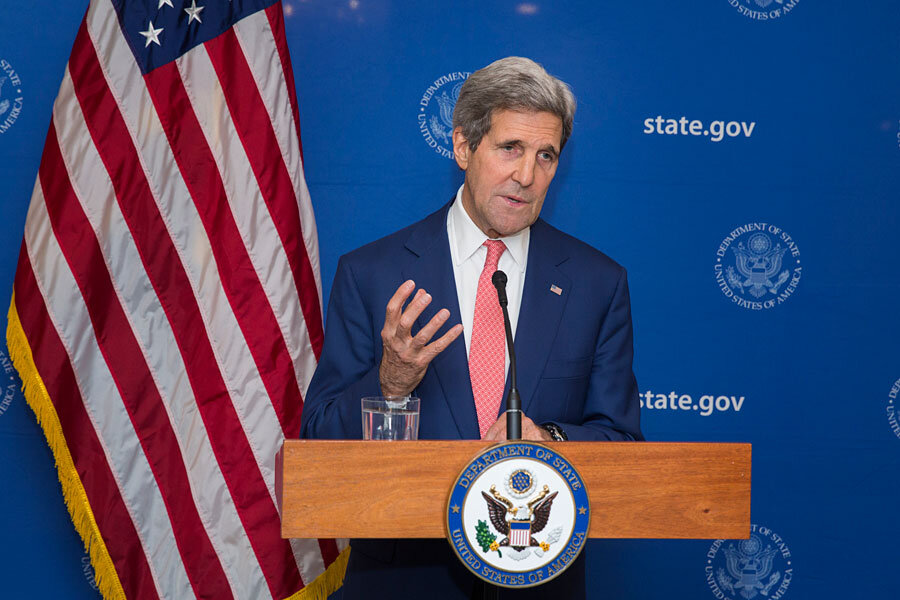Gaza cease-fire: Did it help that US was taking a diplomatic breather?
Loading...
| Washington
Are the chances of Israel and Hamas reaching a durable cease-fire in their devastating war better without the United States in the thick of it?
A week after Secretary of State John Kerry’s fruitless foray into shuttle diplomacy, the announcement late Thursday of a 72-hour humanitarian cease-fire had some in the Middle East thinking so.
In a statement issued jointly by Secretary Kerry, on a trip to India, and United Nations Secretary-General Ban Ki-moon, the UN said it received “assurances” from “all parties” that they would observe a three-day cease-fire beginning Friday morning.
The statement said that during the cease-fire “the forces on the ground will remain in place” – meaning Israeli forces in Gaza would remain, a key Israeli demand for accepting a cease-fire. As soon as a calm in the fighting takes hold, Israeli and Palestinian negotiators are to go to Cairo for talks aimed at a longer-term agreement to end the fighting.
Egypt, which from the beginning of the conflict suggested regional players were up to handling this one, emerges as a key broker in the cease-fire arrangements. Egypt continued its diplomatic efforts Thursday, hosting Israeli officials to discuss cease-fire ideas.
Before Thursday’s cease-fire announcement, some regional experts warned that the diplomatic vacuum left by the US absence could encourage hardliners on both sides to seize the opportunity to impose their positions. Instead of a cease-fire, they said, Israel could opt to reoccupy the Gaza Strip, Hamas would continue to hone its guerrilla warfare, and already high casualties would likely soar on both sides.
Those concerns have not evaporated as a result of the 72-hour humanitarian ceasefire, and pressure to return to fighting could easily resume.
Israeli Foreign Minister Avigdor Lieberman is calling for the Israeli military to be authorized to “go all the way” to reoccupy Gaza and wipe out Hamas’s fighters and local leadership. Prime Minister Benjamin Netanyahu is said to be resisting that option, although earlier Thursday he vowed to destroy all of the Hamas-built tunnels leading into Israel “with or without a cease-fire.”
Also on Thursday the Israeli government called up 16,000 reservists – a move that fueled speculation that the ground war was indeed about to be widened. Israeli military officials said, however, that the reservists would relieve an equal number of soldiers already fighting.
In the meantime, the US appeared to be taking something of a diplomatic breather, even as Kerry, in New Delhi for a long-scheduled US-India “strategic dialogue,” was a co-announcer of the cease-fire.
Kerry, who had been skewered by the Israeli media and some US critics for an earlier cease-fire proposal deemed weak on disarming Hamas, sounded ever-so-slightly relieved at being out of the Middle East snake pit, though not very confident that real progress would be made.
“I think everybody would feel better if there was a bona fide effort to try” to get to a cease-fire and negotiations on the issues underlying the conflict, he said before the cease-fire announcement, but added that there was “no promise” of a quick end to the fighting ending its fourth week.
The US this week authorized replenishment of Israel’s supply of grenades and mortar rounds depleted in its Gaza offensive, while Congress is pushing to add hundreds of millions of dollars to funding for Iron Dome, the antimissile missile system credited with knocking most of Hamas’s rockets heading toward Israeli cities out of the sky.
At the same time the White House issued a stinging rebuke of Israel Thursday for its shelling the day before of a UN-run school-turned-shelter for thousands of Palestinians, calling the action “totally indefensible.”
White House spokesman Josh Earnest said the US “is asking the Israelis … in fact urging the Israelis … to do more to live up to the standards that they have set for their own military operations to protect the lives of innocent civilians.”








